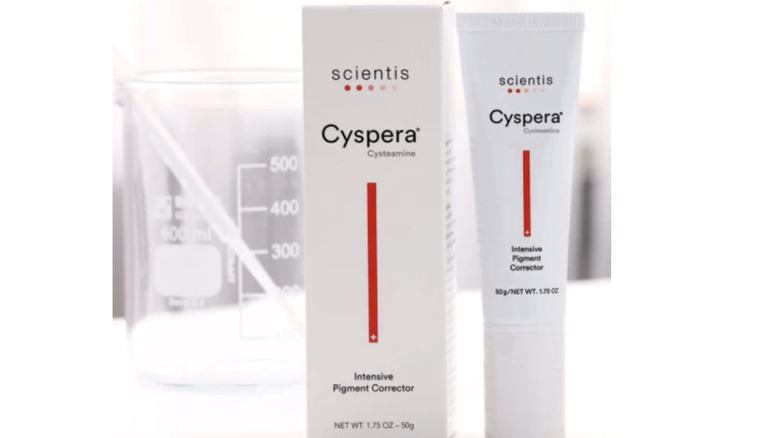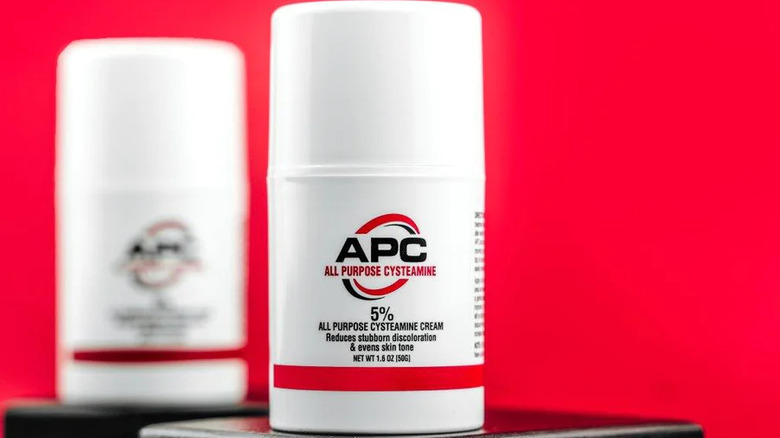What To Know About Cysteamine And Its Skincare Benefits
In the skincare regime, there's never a single solution to cure acne, dark spots, wrinkles, and other skin woes; new oils, creams, and treatments are continuously being developed to help target those issues. In addition, dermatologists are constantly working to create more options for folks with different skin types who can't handle more potent products. You might have heard skincare experts talk about ingredients you want to incorporate into your routine, such as benzoyl peroxide, azelaic acid, niacinamide, and more. Experts have been raving over the new skincare product cysteamine, which helps to treat post-inflammatory hyperpigmentation.
Cysteamine comes in a cream that you can often purchase at your dermatologist's office. While many dermatologists will recommend a similar product — hydroquinone — to treat dark spots since it bleaches the skin, it has a terrible potential side effect: ochronosis, which causes the skin to darken permanently instead of lightening the dark spots if you use hydroquinone for years. So you might wonder how cysteamine is better than hydroquinone if they're supposed to target the same issue. That's why we're here to break down everything you need to know about cysteamine and its skincare benefits.
What is cysteamine?
Cysteamine is similar to hydroquinone. They help lighten the skin and improve melasma, hyperpigmentation, and lentigines (sunspots), and come as a cream or lotion. According to The Clifford Clinic, the Cyspera product system is the first to use cysteamine in its formulations. US Rx states, "the agent in cysteamine reduces the amount of amino acid known as L-cystine or cystine." Cystine helps create melanin, and an influx of melanin causes hyperpigmentation and melasma — so, the cysteamine cream works by preventing melanin from being synthesized.
Your body already contains the cysteamine antioxidant that reduces copper and iron ions, controls melanin production, and increases glutathione, affecting the dark spots on your skin. So it's an ideal alternative to hydroquinone if you don't want anything too strong but something that will still work. In addition, if you use cysteamine for a long time, you won't develop ochronosis, so it's safe to use long-term. The downside to using the cream, as with many skincare products, is that it has a bad smell, but manufacturers have used new technology to make it bearable.
Cysteamine skincare benefits
Cyspera is the first cysteamine product introduced for folks to use on their skin. It's not a common product that you will find at your corner drugstore. However, it is considered a cosmetic item, and the three-step system can be purchased without a prescription at many dermatologist offices (via PR Newswire). Cyspera has multiple benefits other than fading skin discoloration, such as preventing the discoloration from reoccurring and treating melasma.
Cysteamine creams are perfect for women with any skin tone, especially darker skin, and who have tried using other brightening products, like vitamin C, azelaic acid, glycolic acid, or retinoids but haven't seen results. Skincare ingredients like retinoids can sometimes be too harsh on the skin, especially if you have sensitive skin, but cysteamine is skin-friendly for every skin type. Even if you have lighter skin, the cysteamine will work to even any discoloration you might have.
Cysteamine side effects and risks
Cysteamine is safe to use since it's something our skin cells naturally produce, and it's found in breast milk. Using cysteamine creams or lotions is safe for most skin types, but the product has a few side effects. For example, if it's your first time using the cream, you may have a bit of tingling or redness that will go away after 30 minutes. Also, you might have irritation or dry patches, but applying moisturizer will help hydrate them. Most new skincare products you use for the first time will irritate your skin, but the more you use them, your skin will get used to them.
However, cysteamine is still new, so there haven't been a lot of studies that showcase any downsides. Nevertheless, if you're pregnant or breastfeeding, it's recommended not to use the cream or lotion, since no studies have said they're safe to use. In addition, don't use the cysteamine cream if you have vitiligo. While there aren't proven additional risks to those with vitiligo, potential side effects haven't been researched, so you'll want to steer clear.
How to apply cysteamine cream
When using cysteamine cream, there are two phases you'll go through to reach the best results: the intense and maintenance phases. You can apply the cream at any time or during your skincare routine. Cysteamine isn't a photosensitizer, so you can use it at any time of the day. You'll want to follow the cream with sunscreen and other skincare ingredients to protect your skin from developing dark spots.
During the intense phase, you'll apply the cream during your skincare routine once a day for 16 weeks straight. After 16 weeks, you'll enter your maintenance phase, where you'll use the cream once a day, twice a week, for eight to 12 weeks to see optimal results.
Applying the cysteamine cream is extremely simple and only takes a few steps. First, apply a thin layer of the cream to your dry, non-washed face. You'll want to do it in the morning as soon as you wake up, so you're not tempted to wash your face immediately. If you wash your face, wait an hour before applying the cream. Leave the cream on your face for 15 minutes, but note that some tingling or slight burning sensation may occur — this will go away within about half an hour. Then, remove the cream by washing your face with a gentle cleanser. Finally, pat dry and apply the rest of your skincare routine.
Where you can buy cysteamine cream
Since Cyspera and other cysteamine creams aren't products you can buy at Target, Walmart, or CVS, you can visit your dermatologist, and they can set you up with a treatment plan and sell you the necessary products. Dermatologists will be able to walk you through everything you need to know and answer your questions. Sometimes they might prescribe other skincare products that will better suit your hyperpigmentation or melasma, but if you've tried multiple products or ingredients, you can ask for Cyspera.
If you don't want to visit a dermatologist, you can buy Cyspera or other cysteamine creams from limited brands, such as Milk + Honey, The Skin Spot, Senté, or All Purpose Creams (APC). They have different prices ranging from $60 to $170, depending on the size and type of cream you're looking for. For example, APC sells All Purpose Cysteamine that contains 5% cysteamine for $58.85. Milk + Honey has their Cyspera cream with 5% to 7% cysteamine, that's still more gentle than niacinamide, for $170. If you've never tried niacinamide, you can try it before buying cysteamine and see if it will help your discoloration since it's more affordable.





